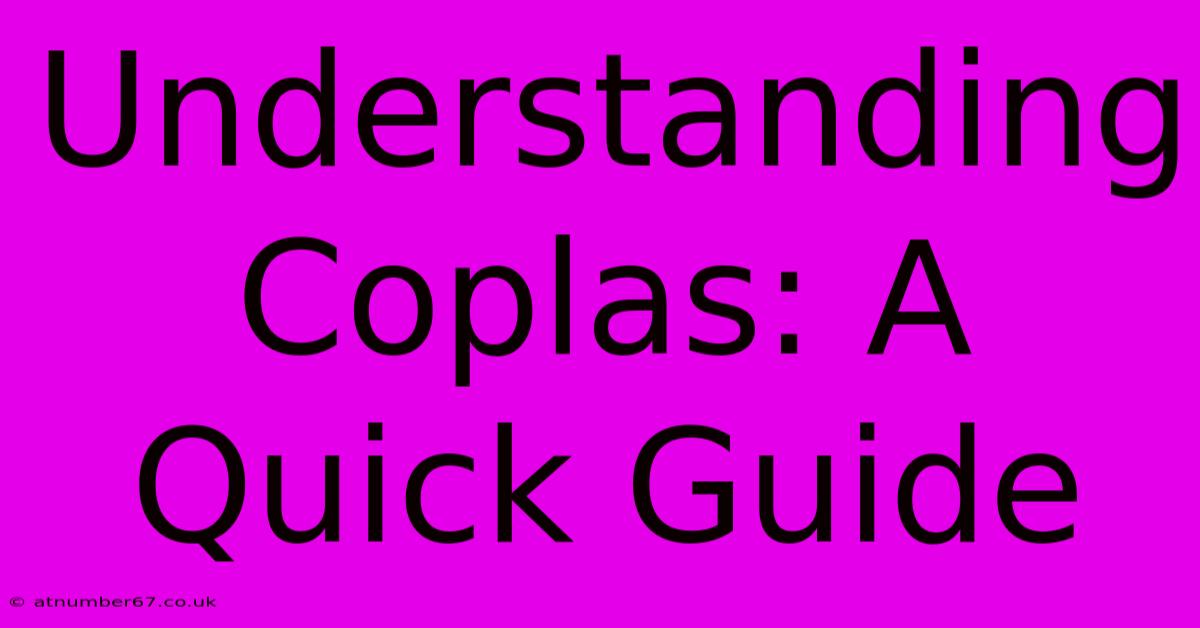Understanding Coplas: A Quick Guide

Table of Contents
Understanding Coplas: A Quick Guide
Coplas. The very word evokes images of ancient Spain, of passionate romances and heartfelt lamentations. But what exactly are coplas? This quick guide will delve into the world of this captivating poetic form, exploring its structure, history, and enduring appeal.
What are Coplas?
Coplas, in their simplest form, are strophic poems, typically featuring four-line stanzas. However, the true beauty of coplas lies not just in their structure, but in their rhythmic and rhyming patterns. They are characterized by their consistent rhyme scheme and metrical regularity, creating a musicality that resonates deeply with the listener or reader. The most common type is the coplas de pie quebrado, characterized by its distinctive rhyme scheme (ABBA) and its use of contrasting lines, often creating a sense of tension or surprise.
Key Characteristics of Coplas:
- Four-line stanzas: This is the fundamental building block of a copla.
- Rhyme scheme: Often ABAB or ABBA, creating a strong sense of musicality and structure. Other variations exist, but these are the most common.
- Meter: Coplas adhere to a specific metrical pattern, typically using eight-syllable lines (octosyllabic) in Spanish. This contributes to the poem's rhythmic flow.
- Themes: Coplas can explore a wide range of themes, from love and loss to social commentary and religious devotion. They are incredibly versatile in their subject matter.
A Brief History of Coplas:
Coplas have a rich and fascinating history, deeply intertwined with the cultural fabric of Spain. Their origins can be traced back to medieval times, evolving through different styles and periods. The cancionero tradition, a collection of lyrical poems popular in 15th and 16th century Spain, preserved numerous examples of coplas, showcasing their diverse forms and themes. Jorge Manrique, a 15th-century Spanish nobleman, is particularly renowned for his masterful Coplas a la muerte de su padre (Coplas to the Death of his Father), a poignant reflection on mortality that remains a celebrated work in Spanish literature. These coplas are a powerful testament to the enduring power of this poetic form.
The Enduring Legacy of Coplas:
Despite their origins in medieval Spain, coplas continue to resonate with audiences today. Their ability to express complex emotions with clarity and conciseness makes them a powerful and enduring form of poetic expression. Their musicality and structure lend themselves well to being set to music, further enhancing their emotional impact. You'll find coplas in various forms of traditional Spanish music and song.
Understanding the Structure: Deconstructing a Copla
Let's examine a simplified example to better understand the structure. While this example avoids the intricacies of traditional Spanish meter, it illustrates the fundamental ABAB rhyme scheme:
- Line 1: The sun shines bright (A)
- Line 2: Upon the mountain high (B)
- Line 3: The birds all sing a song (A)
- Line 4: Beneath the azure sky (B)
This simple example shows the core structure: four lines, consistent rhyme scheme, and a sense of completion within each stanza. Traditional coplas will have a much richer complexity.
Beyond the Basics: Exploring Different Types of Coplas
While the coplas de pie quebrado are the most well-known, there are other variations, each with its unique structural characteristics and lyrical qualities. Further research into these diverse forms will unveil a deeper understanding of the richness and versatility of coplas. Learning more about the nuances of these forms will enrich your appreciation of this powerful poetic form.
Conclusion:
Coplas offer a captivating glimpse into the heart of Spanish culture and poetic tradition. Their structured beauty, combined with their ability to convey deep emotion, ensures their continued relevance and appeal. By understanding their structure, history, and themes, we gain a deeper appreciation for this enduring form of poetic expression. So, delve into the world of coplas, and discover the magic they hold!

Thank you for visiting our website wich cover about Understanding Coplas: A Quick Guide. We hope the information provided has been useful to you. Feel free to contact us if you have any questions or need further assistance. See you next time and dont miss to bookmark.
Featured Posts
-
Ms Dhonis Net Worth Financial Success Secrets
Apr 03, 2025
-
Al Greens Net Worth A Congressmans Lifestyle Revealed
Apr 03, 2025
-
Gyanendra Shahs Age A New Perspective
Apr 03, 2025
-
Unlocking The Mystery Jurnee Smolletts True Net Worth
Apr 03, 2025
-
Birthday Wishes From A Mom Who Admires Her Daughter
Apr 03, 2025
